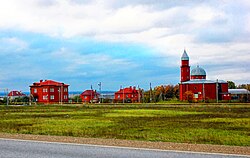Arrival in Kosovo
After the Circassian genocide following the Russo-Circassian War, large number of Circassians were exiled to the Ottoman Empire, including in Kosovo. [1] Between 1858 and 1862, 6,000 Circassian families settled in Kosovo. [1] [4] Other Circassians were settled in Niš and Prokuplje between 1862 and 1863. [1] [5] Around 12,000 Circassians were once again sent to Kosovo and Serbia in following months. [1] [6] In total, 40,000 Circassians were settled in Kosovo alone. [7]
The Ottoman Empire aimed to make life easier for the newly arrived Circassians, and did not tax them and they were provided with materials to farm with. [1] [2] The Circassians were not well received by both Albanians and Serbs. [8] Both Albanians and Serbs considered the Circassians to be wild and primitive Barbarians. [8] People of the Kosovo region as well as some regional governors helped Circassians. [1] [9] [10] Since there was no mosque in Babimusa at the time, where more than 200 Circassian families were settled, the local administration started to work on the construction of a mosque at the end of 1864. [1] [11]
Decrease in population
Majority leaving the region (1877–1878)
The Circassians in Bulgaria fiercely opposed the Bulgarian Revolt in 1876. Kosovo Circassians also joined the Bulgarian Circassians. [1] [2] European countries in turn demanded that the Circassians leave the region. [12]
Circassians sided with the Ottoman army during the Russo-Turkish War (1877–1878). [2] After the war, the Circassians were seen as a "Muslim threat" and expelled from Kosovo, Bulgaria and other parts of the Balkans by Russian armies following the end of the Russo-Turkish war. They were not allowed to return, [13] [14] so the Ottoman authorities settled them in new other lands such as in modern Jordan (see Circassians in Jordan), where they would have conflict with Bedouin Arabs, [15] and Turkey (see Circassians in Turkey). [16]
Persecution by Albanians and Last remnants leaving for Adygea (1998-1999)
When the Kosovo War began, the Circassians in Kosovo emigrated to their ancestral homeland, Republic of Adygea, where they founded a village named Mafekhabl near the republic's capital of Maykop. [17] Muammar Gaddafi sent support and donations to the village. Gaddafi, according to his own words, showed a deep respect for the Circassians and their historical suffering. [18] Immigrants unanimously recount peaceful coexistence with Serbs, contrasting with Albanian hostility towards Circassians. [19] Circassian children faced frequent bullying by Albanians at school, while adults endured robberies, arson, and sniper attacks in the fields. [19] Kosovo Circassians sought lawfulness within Yugoslavia, resisting Albanian pressure for insubordination. [19] This refusal branded them traitors. [19] Tensions escalated in Stanoc i Epërm, leading to segregated communities and forced "parallel education" for Circassian children. [19] Seeking protection, they formed Circassian self-defense brigades with Serb support. [19]



